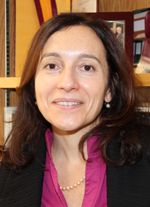

Main navigation | Main content

Professor Laura Gagliardi has received the Bourke Award from the Royal Society of Chemistry, honored for her contributions to quantum chemistry focused on predicting new materials for catalysis, gas separation, and excited state phenomena.
This award honors the top scientists in their fields for the originality of their research, the impact of their research, quality of their publications, patents or software, innovation, professional standing, and collaborations and teamwork. Gagliardi will receive £2000 and a medal, and she will undertake a lecture tour in the United Kingdom. The list of previous recipients of this award, which was started in 1955, includes, among others, Mark Ratner (2011), George C Schatz (2007), Marsha Lester (2005), Steve R Leone (1995), and Ilya Prigogine (1972).
Gagliardi is one of the most highly accomplished theoretical and computational chemists in the world. Her work involves the prediction and modeling of chemical phenomena by means of advanced chemical computation. She leads the highly collaborative and multi-disciplinary Inorganometallic Catalyst Design Center, which is an Energy Frontier Research Center funded by the Department of Energy. This center focuses on the computationally guided discovery of a new class of energy-science-relevant catalytic materials and the underlying structure–function relationships that will guide further catalyst discovery. She obtained the federal funding for and is now associate director of the Nanoporous Materials Genome Center, which discovers and explores microporous and mesoporous materials, including metal-organic frameworks, zeolites, and porous polymer networks.
“What sets her apart from many is her unusually broad perspective arising from a background spanning physical, inorganic and materials chemistry, and the ability to develop and use computational chemistry tools to address challenging problems,” said Regents Professor Donald Truhlar, who is Professor Gagliardi’s colleague and who collaborates with her on many research initiatives.
“Gagliardi’s spectacular success derives from her ability to combine the explanation of otherwise puzzling chemical phenomena with predictions for new materials and properties,” said Truhlar. “She is a fearless computational quantum chemist who knows how to achieve synergy with experimental collaborators and push computational chemistry to the limit to solve fascinating chemical problems.”
Gagliardi develops new electronic-structure methods that have led to paradigm-shifting improvements in the understanding of complex inorganic systems and their properties, which are important for applications ranging from energy sustainability to nuclear waste management. Her work on chemical bonds has changed the way chemists think about how metal atoms interact by showing that one could go beyond a quadruple bond. This new way of thinking about chemical bonds has had a deep effect on physical chemistry, inorganic chemistry, and materials science.
Another major discovery from Gagliardi’s research group includes the characterization of the range of possible structures and properties associated with a relatively new class of nanostructured materials called metal organic frameworks (MOFs). Recently, she developed a methodology to simulate CO2 capture within MOFs, possibly leading to the capture of greenhouse gas from the atmosphere and waste streams.
Professor Gagliardi is also an expert in electronic spectroscopy, employing multi-reference quantum chemical methods to explain phenomena involving excited states of system containing transition metals and also organic molecules. In the last five years, she has worked with experimentalists to understand the nature of metal-metal multiply bonded systems, their excited state properties, and their contribution to photo-catalysis phenomena.
She has improved the methodology for wave function modeling of transition metal systems that are not addressable with conventional routes. Currently, her group studies systems with up to 200 atoms, several of which are heavy, by using these approaches. She is now working on new density functional methods that will extend the range of systems amenable to quantitative prediction even further.
Gagliardi is a Distinguished McKnight University Professor. She earned her doctorate from the University of Bologna, Italy, and was a post-doctorate at the University of Cambridge. She joined the Department of Chemistry faculty in 2009.